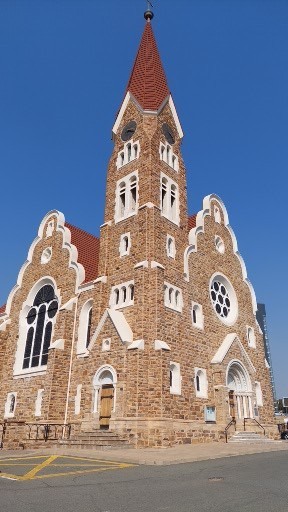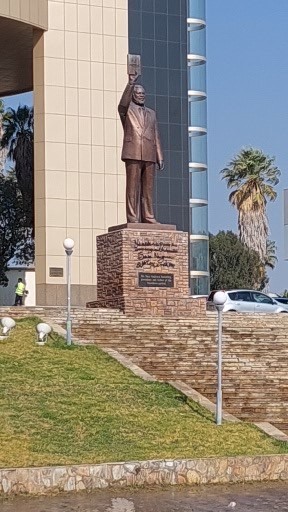#Sam Nujoma
Explore tagged Tumblr posts
Text
https://www.reuters.com/world/africa/namibias-founding-father-sam-nujoma-dies-aged-95-presidency-says-2025-02-09/
0 notes
Text
21 mars : la fête nationale de la Namibie
La Namibie a été un des derniers pays à obtenir son indépendance. L’ancien Sud-Ouest africain allemand, théâtre du premier génocide du XXe siècle, a été occupé par l’Afrique du Sud en 1915. Après la défaite allemande de 1918, la colonie allemande a été confiée à l’Afrique du Sud par la SDN. Elle a administré le pays jusqu’en 1990. L’ONU avait adopté une résolution en 1978 prévoyant l’émancipation du pays. il a fallu une décennie à l’Afrique du Sud pour accepter de mettre en œuvre la résolution. La transition de la Namibie vers l'indépendance a commencé en 1989 et s'est terminée le 21 mars 1990, lorsque le pays a officiellement obtenu son indépendance de l'Afrique du Sud. Le Jour de l'Indépendance (Indépendance Day) est la fête nationale de la Namibie. La fête est marquée par des défilés, des fêtes de rue, des compétitions sportives et d'autres événements festifs organisés dans tout le pays.
le Dr Sam Nujoma devenant président fondateur d'un État indépendant et souverain, la République de Namibie. Le président Nujoma a démissionné en 2005 après avoir accompli trois mandats. Une transition démocratique en douceur du pouvoir a suivi lorsque Hifikepunye Pohamba a été élu président en novembre 2004. En novembre 2014, le Dr Hage G. Geingob a été élu président alors qu'il était Premier ministre. Le Dr Hage Geingob a été nommé président de la Namibie le 21 mars 2015. Il est mort en février 2024, Nangolo Mbumba, le vice-président, lui a succédé.
Cette année, la célébration du 34e anniversaire de l'indépendance de la Namibie a lieu à Katima Mulilo, une première historique pour la région du Zambèze. En effet, Les célébrations du Jour de l'Indépendance se déroulent à tour de rôle entre les régions. En 2024, l’événement a lieu sous le thème « Un peuple uni pour la prospérité ».
Un article de l'Almanach international des éditions BiblioMonde, 20 mars 2024
0 notes
Text
SAM NUJOMA BIOGRAPHY, EDUCATION, CAREER, CONTROVERSIES AND DEATH
SAM NUJOMA BIOGRAPHY- Samuel Shafiishuna Daniel Nujoma, born on 12 May 1929 in Etunda, Ongandjera, near Okahao, Ovamboland (now part of Namibia), was a pivotal figure in the fight against apartheid and a key leader in the struggle for Namibia’s independence. He served as Namibia’s first president from 1990 to 2005, having been elected after the country gained independence from South Africa. SAM…
0 notes
Text
Jetzt ist die Reise losgegangen. Gestern brachte uns unser Nachbar Giulio nach Wörgl, mit Zug und Bus erreichten wir Innsbruck, flogen mit nur 20 Minuten Verspätung nach Frankfurt, wo wir ohnehin 5 Stunden Aufen5gehabt hätten. Wir checkten zwar pünktlich ein, wegen eines starken Unwetters mussten aber alle Checkins am gesamten Flughafen für 1,5 h gestoppt werden. Deswegen und weil wir wegen des Konflikts in Niger einen Umweg fliegen mussten, erreichten wir den Zielflughafen in Windhoek mit 4 h Verspätung um 11.00. Die Passkontrolle gestaltete sich sehr gemütlich. Unser Transfertaxi musste also ordentlich warten und brachte uns in 40 Minuten in unser schönes Quartier in Windhoek, da wir schnell bezogen und gleich mit einem Taxi ins Zentrum fuhren. Dieses brachte uns zu diversen Sehenswürdigkeiten wie den 120 Jahre alten schnuckeligen Bahnhof, das Kududenkmal oder die kleine katholische Kirche. Bei der Tintnenburg, dem Parlament, stiegen wir aus, spazierten zur schnuckeligen Christuskirche- auch geschlossen - und zum Unabhängigkeitsmuseum. Dieses wurde von Nordkorea!!! gebaut, von dortigen Gefangenen, die dafür danach freikamen. Aber weder innen noch außen wurden lokale Menschen eingebunden, was für ein Nationalmuseum schon krass ist. Schließlich spazierten wir zu 3 kleinen Burgen. Eine ließ sich der deutsche Statthalter vor 100 Jahren bauen, da ist jetzt die italienische Botschaft drinnen, eine ließ er für seine Frau errichten- die wollte standesgemäß alleine wohnen- und jetzt ist ein 5 Sterne Hotel drinnen. Die Terrasse ist wahrscheinlich der schönste Platz in Windhoek. Und das beste ist für uns ja nur gut genug. Ein guter Aperitiv, dann setzten wir uns zum fürstlichen Essen- Onyxfleisch für Franz, das ist eine Gazellenart- in eine Burgkammer, weil der Wind Franz nicht behagte, es heißt nicht umsonst Windhoek. Zum Sundowner wieder ein Coctail auf der Terrasse. Besser hätte unser Urlaub nicht beginnen können.


0 notes
Text
Un hommage rendu à Dakar, au héros namibien Sam Nujoma
Un hommage solennel a été rendue samedi, à un acteur majeur à la lutte de Libération de l’Afrique et à la création de la République de Namibie. Il s’agit du Premier chef d’Etat de la namibien Samuel Nujoma, décédé le 8 février 2025. L’impact de la bravoure du père fondateur de la Namibie dépasse les frontières. « Avec une trentaine d’années passées en exil, celui qui fut à l’avant-garde de…
0 notes
Text
La Namibie et les dirigeants africains licencient le premier président et le "père fondateur" du pays lors des funérailles de l'État
Madrid 2 mars (Europa Press) – L'ancien président de la Namibie et “père fondateur du pays”, Sam Shafiishuna Nujoma, qui a été le premier président à être choisi démocratiquement après l'indépendance de son domaine sud-africain, a été enterré ce samedi lors de funérailles de la capitale, Windhoek à qui les dirigeants africains ont fréquenté. À la loi, tenue dans le monument acre des héros, le…
#africains#des#dirigeants#fondateur#funérailles#l39État#Les#licencient#lors#Namibie#pays#père#Premier#président
0 notes
Link
Namibie : Sam Nujoma, père de l’indépendance et acteur clé de l’homophobie d’État en Afrique, est décédé à 95 ans.
0 notes
Text
Sam Nujoma, Namibia’s fiery freedom fighter and first president, dies aged 95
OSHAKATI, Namibia — Sam Nujoma, the fiery, white-bearded freedom fighter who led Namibia to independence from apartheid South Africa in 1990 and served as its first president for 15 years, and became known as the father of his nation, has died. He was 95. Nujoma’s death was announced Sunday by current Namibian President Nangolo Mbumba, who said Nujoma died on Saturday night after being…
0 notes
Text
Tributes for Namibian independence leader Nujoma, dead at 95
WINDHOEK: Sam Nujoma, who led a three-decade-long fight for Namibia’s independence from apartheid South Africa, has died aged 95, the presidency announced Sunday. Tributes poured in for the southern African country’s “founding father”, with South Africa’s President Cyril Ramaphosa crediting Nujoma as an inspiration for his own country’s struggle against white minority rule. The SWAPO liberation…
0 notes
Text
Sam Nujoma, Namibia’s fiery freedom fighter and first president, dies aged 95 | The Hill
https://thehill.com/homenews/ap/ap-international/ap-sam-nujoma-namibias-fiery-freedom-fighter-and-first-president-dies-aged-95/?tbref=hp
0 notes
Link
0 notes
Text
Mort à 95 ans de Sam Nujoma, père de l’indépendance de la Namibie
Héros de l’indépendance et premier président de la Namibie dont il a longtemps dominé le paysage politique, Sam Nujoma est mort à 95 ans, ont annoncé dimanche les autorités de ce pays désertique d’Afrique australe. « Notre père fondateur a vécu une vie longue et déterminante » jusqu’à son décès samedi soir, après trois semaines d’hospitalisation, a indiqué la présidence namibienne dans un…
#Assemblée Nationale#Barthélémy Dias#législatives#Macky#Macky Sall#MALI#Ousmane Sonko#Sonko#TOUBA#Yewwi askan wi
0 notes
Text
Sam Nujoma from Namibia dead in 95
His father Daniel Uoni Nujoma and his mother, Mingan-Helli condomolo, worked on the ground. As a boy, Mr. Nujoma said in his memory, he had cared for family cattle and goats, and carried the child on his back to liberate his mother to work in the fields. With only modest formal education, Mr. Nujoma, at the age of 17, moved to Walvis Bay coastal enclave, where he worked at the General and Whale…
0 notes